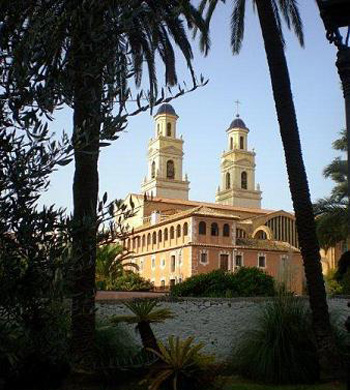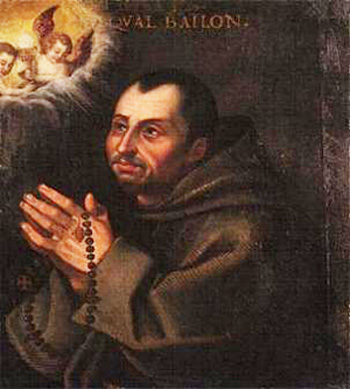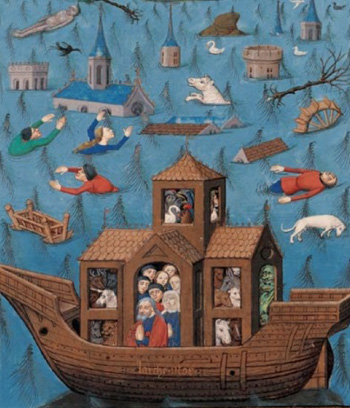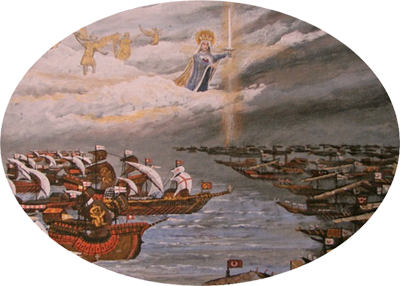The Saint of the Day
 |
 |
 |
 |
 |
 |
 |
St. Paschal Baylon - May 17
Biographical selection:
St. Paschal Baylon, whose body rests in the Franciscan Monastery in Villarreal, Spain, died in 1592.
 He was born in the Kingdom of Aragon and was a shepherd in his youth. Before taking the flock out to pasture, he attended Mass when he could. If this were not possible, he would await the sound of the bell of small church nearby, and would kneel in the field at the time of the Elevation to adore the Blessed Sacrament, the Savior
Who descends from Heaven to the altar.
He was born in the Kingdom of Aragon and was a shepherd in his youth. Before taking the flock out to pasture, he attended Mass when he could. If this were not possible, he would await the sound of the bell of small church nearby, and would kneel in the field at the time of the Elevation to adore the Blessed Sacrament, the Savior
Who descends from Heaven to the altar.
At age 24 he became a Discalced Franciscan brother in Villareal and there he showed the same ardent fervor for the Blessed Sacrament. God rewarded him by calling him from this life at the moment of the Elevation. After receiving the Holy Viaticum, he asked if the Mass had begun yet in the Monastery Chapel. He was told that it had and the Elevation was near at hand. He waited attentively for the sound of the small bells. At that moment he exclaimed, "My Jesus!" and died.
His funeral was marked by a great miracle. His coffin was in the Chapel and the Office of the Dead started. At the moment of the Elevation of the Host, the corpse moved and opened its eyes; when the priest raised the Chalice, his dead body made the same movement.
Later, his body was placed close to the Main Altar. Each time that a Mass was celebrated on that Altar and as the moment of the Elevation approached, movements inside his coffin were heard inviting the faithful to increase their fervor and adore the Holy Sacrament.
This continues to our days; at times one hears the sound of movement inside St. Paschal Baylon's coffin.
Comments of Prof. Plinio:
This selection is very interesting for both its positive and negative aspects. I will start with the negative.
The negative is the way the life of this Saint in presented, which can give the completely wrong impression of what sanctity is.
So, the Saint is a boy who goes to Mass when he can and has great devotion to the Blessed Sacrament. We cannot see why this makes one a saint. It is a very advisable thing to do, but it is not enough to make one a saint.
Then, on the days he cannot attend Mass he attentively waits to hear the sound announcing the Elevation and kneels to adore the Holy Sacrament. It is very laudable, but again it is an act of piety that is within the reach of any pious person. This action alone does not characterize sanctity.
 Then, the selection goes straight to his death. It gives us the impression that
throughout his life this was all he did. Thus, for his first 24 years he simply knelt when he heard the sound of the bell and adored the Holy Eucharist. Then, he returned to take care of his flock.
Then, the selection goes straight to his death. It gives us the impression that
throughout his life this was all he did. Thus, for his first 24 years he simply knelt when he heard the sound of the bell and adored the Holy Eucharist. Then, he returned to take care of his flock.
We have not the slightest doubt that this is very virtuous and is well founded in dogma; but we also have no doubt that this is not enough to characterize a saint. I know little about the life of St. Paschal Baylon, but all of us know what a Saint is.
According to the Catholic doctrine a Saint is he who practices virtue in a heroic degree. If he did not, he cannot be canonized. It is not enough for him to practice virtue heroically; he must work miracles; he also needs to pass the test of the orthodoxy of his doctrine and other such things. But the heroic practice of virtue is the substance of sanctity.
In any case, the facts narrated here do not indicate this heroism.
Now, let me point out the positive side. After his death his movement inside the coffin indicated a miracle. It was a grace that Our Lord gave to glorify the Saint and to glorify Himself. It was a grace eloquently signifying how he had been an ardent devotee of the Most Holy Sacrament. This speaks much more of his heroic virtue than those two small facts we read before.
Certainly he had a blazing love for the Blessed Sacrament; he had that mysterious hunger and thirst for the Holy Eucharist that many Saints had, which produced so many miracles. For this reason, after his death Divine Providence desired that his body should provide the occasion for remarkable miracles, showing the adoration he had for the Blessed Sacrament, and also giving a proof of the real presence of Our Lord in the Holy Sacrament of the Altar.
 In his coffin he moved and lifted his eyes following the gesture of priest elevating the Chalice. On other occasions, after the coffin had been closed, the cadaver would move inside it, making a noise
that would invite those present to adore the Holy Sacrament.
In his coffin he moved and lifted his eyes following the gesture of priest elevating the Chalice. On other occasions, after the coffin had been closed, the cadaver would move inside it, making a noise
that would invite those present to adore the Holy Sacrament.
These are impressive miracles. God animated the cadaver so that it would produce a noise that made others understand how ardent his love had been for the Holy Sacrament. It was as if a remnant of that love still lived in the cadaver.
The movement of a cadaver is more convincing, from a certain point of view, than the resurrection of a dead person, because in the resurrection an incredulous observer can question whether the person had really died before or had only appeared to be dead. But a cadaver that moves is totally inexplicable. From this point of view, the apologetic value of this movement is especially significant as a proof of the action of God upon the cadaver.
Why did this happen in the 16th century? The 16th century was marked by the Protestant Revolution and the real presence of Our Lord in the Blessed Sacrament is one point that all the Protestant sects deny. So, Divine Providence worked various miracles to prove the Real Presence.
The Real Presence can be proved based on the Scriptures and Tradition as well as on the Magisterium of the Church. But since those proofs are not accessible to everyone – they demand study, reflection and a certain level of culture – we understand that Divine Providence mercifully desired to work miracles to make it easier for many more people to accept this truth.
A miracle made at the Elevation of the Host, therefore, at the moment of the Consecration, was a miracle which proved that Our Lord was really present in the Holy Sacrament. Therefore, you see that those miracles at the coffin of St. Paschal Baylon not only had an apologetic value, but a polemical value, because they came at the moment when the matter was lively and hot.
You could ask: Why do we not have more miracles like this today? Why did Divine Providence desire to work miracles to counter Protestantism, the First Revolution, and yet does not do the same against Communism, the Third Revolution, and the Fourth Revolution, Tribalism?
 It is because at that time there was a great surge of Faith. When the Faith that moves mountains disappears, miracles become rare. The miracle is made to confirm the Faith of many, but it is also fruit of the Faith of others. It was because there was Faith that miracles were abundant.
It is because at that time there was a great surge of Faith. When the Faith that moves mountains disappears, miracles become rare. The miracle is made to confirm the Faith of many, but it is also fruit of the Faith of others. It was because there was Faith that miracles were abundant.
Is it only this? Or is it also because we are in an epoch similar to the time of the Deluge? On the eve of the Deluge, I believe that miracles became scarce. God was preparing for a spectacular intervention. The rain in itself is not a miracle. The miracle was to prepare Noah to survive the Deluge.
So, we can also ask whether Divine Providence today is not reserving its miracles for the Chastisement. I believe that during the Chastisement there will be miracles for the spiritual and physical salvation of those who fight for Our Lady.
Even if the design of the Providence were for us to pass through some trial like that of the Prophet Daniel, who entered a cave with lions and left it alive and intact and then was thrown into a burning furnace, we should expect to emerge unscathed as he did, or like St. John who was plunged into a boiling caldron of oil and remained unharmed. Even if this were to happen to us, we should expect to be guarded by Our Lady’s special protection and thus reach the Reign of Mary.
I believe that the day will come when the road for the Counter-Revolution will be the road of miracles. It will require from us a great deal of Faith, a Faith like that of St. Paschal Baylon. Let us ask him to intercede for us that we might be granted this Faith.
Since my early days as a member of a Marian Congregation, my attention was caught by the words in one of its hymns: "Who fights under the shadow of the Immaculate Virgin does not fear the swords of a thousand soldiers."
There will come a moment when every true Catholic will have to face a thousand soldiers. He should not fear the weapons of those soldiers because he will be fighting under the shadow of the Immaculate Virgin!
We need to be prepared for this. We need to have our souls open to miracles.



The Saint of the Day features highlights from the lives of saints based on comments made by the late Prof. Plinio Corrêa de Oliveira. Following the example of St. John Bosco who used to make similar talks for the boys of his College, each evening it was Prof. Plinio’s custom to make a short commentary on the lives of the next day’s saint in a meeting for youth in order to encourage them in the practice of virtue and love for the Catholic Church. TIA thought that its readers could profit from these valuable commentaries.
The texts of both the biographical data and the comments come from personal notes taken by Atila S. Guimarães from 1964 to 1995. Given the fact that the source is a personal notebook, it is possible that at times the biographic notes transcribed here will not rigorously follow the original text read by Prof. Plinio. The commentaries have also been adapted and translated for TIA’s site.
St. Paschal Baylon, whose body rests in the Franciscan Monastery in Villarreal, Spain, died in 1592.

The grand basilica of St. Paschal Baylon in Villareal
At age 24 he became a Discalced Franciscan brother in Villareal and there he showed the same ardent fervor for the Blessed Sacrament. God rewarded him by calling him from this life at the moment of the Elevation. After receiving the Holy Viaticum, he asked if the Mass had begun yet in the Monastery Chapel. He was told that it had and the Elevation was near at hand. He waited attentively for the sound of the small bells. At that moment he exclaimed, "My Jesus!" and died.
His funeral was marked by a great miracle. His coffin was in the Chapel and the Office of the Dead started. At the moment of the Elevation of the Host, the corpse moved and opened its eyes; when the priest raised the Chalice, his dead body made the same movement.
Later, his body was placed close to the Main Altar. Each time that a Mass was celebrated on that Altar and as the moment of the Elevation approached, movements inside his coffin were heard inviting the faithful to increase their fervor and adore the Holy Sacrament.
This continues to our days; at times one hears the sound of movement inside St. Paschal Baylon's coffin.
Comments of Prof. Plinio:
This selection is very interesting for both its positive and negative aspects. I will start with the negative.
The negative is the way the life of this Saint in presented, which can give the completely wrong impression of what sanctity is.
So, the Saint is a boy who goes to Mass when he can and has great devotion to the Blessed Sacrament. We cannot see why this makes one a saint. It is a very advisable thing to do, but it is not enough to make one a saint.
Then, on the days he cannot attend Mass he attentively waits to hear the sound announcing the Elevation and kneels to adore the Holy Sacrament. It is very laudable, but again it is an act of piety that is within the reach of any pious person. This action alone does not characterize sanctity.

A sentimentalist’s St. Paschal: Lacking militancy, heroism & sacrality
We have not the slightest doubt that this is very virtuous and is well founded in dogma; but we also have no doubt that this is not enough to characterize a saint. I know little about the life of St. Paschal Baylon, but all of us know what a Saint is.
According to the Catholic doctrine a Saint is he who practices virtue in a heroic degree. If he did not, he cannot be canonized. It is not enough for him to practice virtue heroically; he must work miracles; he also needs to pass the test of the orthodoxy of his doctrine and other such things. But the heroic practice of virtue is the substance of sanctity.
In any case, the facts narrated here do not indicate this heroism.
Now, let me point out the positive side. After his death his movement inside the coffin indicated a miracle. It was a grace that Our Lord gave to glorify the Saint and to glorify Himself. It was a grace eloquently signifying how he had been an ardent devotee of the Most Holy Sacrament. This speaks much more of his heroic virtue than those two small facts we read before.
Certainly he had a blazing love for the Blessed Sacrament; he had that mysterious hunger and thirst for the Holy Eucharist that many Saints had, which produced so many miracles. For this reason, after his death Divine Providence desired that his body should provide the occasion for remarkable miracles, showing the adoration he had for the Blessed Sacrament, and also giving a proof of the real presence of Our Lord in the Holy Sacrament of the Altar.

A good depiction of St. Paschal expressing a serious, heroic soul
These are impressive miracles. God animated the cadaver so that it would produce a noise that made others understand how ardent his love had been for the Holy Sacrament. It was as if a remnant of that love still lived in the cadaver.
The movement of a cadaver is more convincing, from a certain point of view, than the resurrection of a dead person, because in the resurrection an incredulous observer can question whether the person had really died before or had only appeared to be dead. But a cadaver that moves is totally inexplicable. From this point of view, the apologetic value of this movement is especially significant as a proof of the action of God upon the cadaver.
Why did this happen in the 16th century? The 16th century was marked by the Protestant Revolution and the real presence of Our Lord in the Blessed Sacrament is one point that all the Protestant sects deny. So, Divine Providence worked various miracles to prove the Real Presence.
The Real Presence can be proved based on the Scriptures and Tradition as well as on the Magisterium of the Church. But since those proofs are not accessible to everyone – they demand study, reflection and a certain level of culture – we understand that Divine Providence mercifully desired to work miracles to make it easier for many more people to accept this truth.
A miracle made at the Elevation of the Host, therefore, at the moment of the Consecration, was a miracle which proved that Our Lord was really present in the Holy Sacrament. Therefore, you see that those miracles at the coffin of St. Paschal Baylon not only had an apologetic value, but a polemical value, because they came at the moment when the matter was lively and hot.
You could ask: Why do we not have more miracles like this today? Why did Divine Providence desire to work miracles to counter Protestantism, the First Revolution, and yet does not do the same against Communism, the Third Revolution, and the Fourth Revolution, Tribalism?

God is preparing a spectacular intervention for
our times, analogous to the Great Deluge
Is it only this? Or is it also because we are in an epoch similar to the time of the Deluge? On the eve of the Deluge, I believe that miracles became scarce. God was preparing for a spectacular intervention. The rain in itself is not a miracle. The miracle was to prepare Noah to survive the Deluge.
So, we can also ask whether Divine Providence today is not reserving its miracles for the Chastisement. I believe that during the Chastisement there will be miracles for the spiritual and physical salvation of those who fight for Our Lady.
Even if the design of the Providence were for us to pass through some trial like that of the Prophet Daniel, who entered a cave with lions and left it alive and intact and then was thrown into a burning furnace, we should expect to emerge unscathed as he did, or like St. John who was plunged into a boiling caldron of oil and remained unharmed. Even if this were to happen to us, we should expect to be guarded by Our Lady’s special protection and thus reach the Reign of Mary.
I believe that the day will come when the road for the Counter-Revolution will be the road of miracles. It will require from us a great deal of Faith, a Faith like that of St. Paschal Baylon. Let us ask him to intercede for us that we might be granted this Faith.
Since my early days as a member of a Marian Congregation, my attention was caught by the words in one of its hymns: "Who fights under the shadow of the Immaculate Virgin does not fear the swords of a thousand soldiers."
There will come a moment when every true Catholic will have to face a thousand soldiers. He should not fear the weapons of those soldiers because he will be fighting under the shadow of the Immaculate Virgin!
We need to be prepared for this. We need to have our souls open to miracles.

‘Who fights under the shadow of the Immaculate Virgin
does not fear the swords of a thousand soldiers.’

 | |
|
|
The texts of both the biographical data and the comments come from personal notes taken by Atila S. Guimarães from 1964 to 1995. Given the fact that the source is a personal notebook, it is possible that at times the biographic notes transcribed here will not rigorously follow the original text read by Prof. Plinio. The commentaries have also been adapted and translated for TIA’s site.


